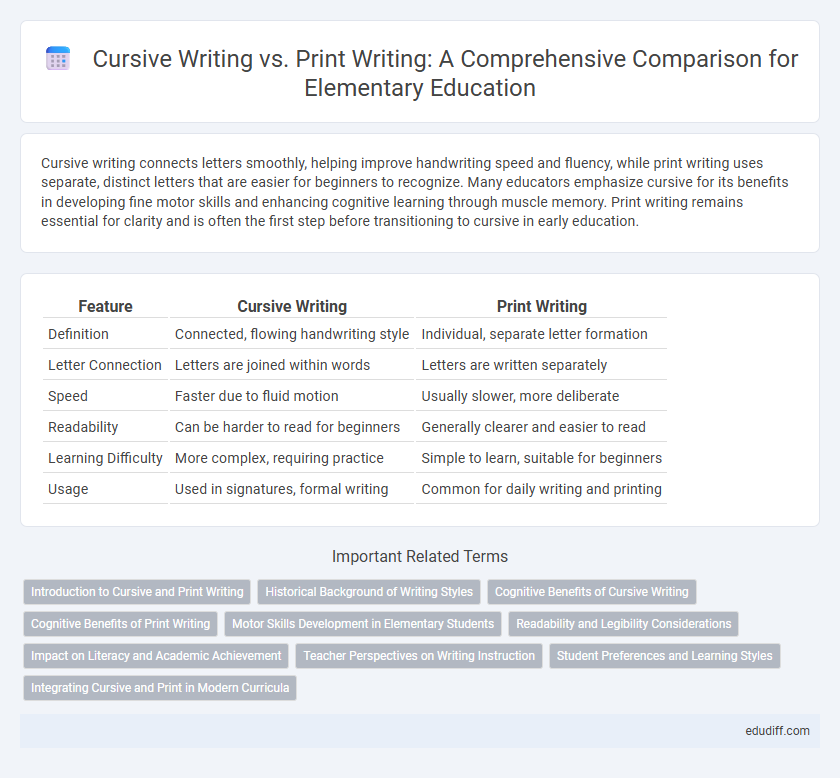Cursive writing connects letters smoothly, helping improve handwriting speed and fluency, while print writing uses separate, distinct letters that are easier for beginners to recognize. Many educators emphasize cursive for its benefits in developing fine motor skills and enhancing cognitive learning through muscle memory. Print writing remains essential for clarity and is often the first step before transitioning to cursive in early education.
Table of Comparison
| Feature | Cursive Writing | Print Writing |
|---|---|---|
| Definition | Connected, flowing handwriting style | Individual, separate letter formation |
| Letter Connection | Letters are joined within words | Letters are written separately |
| Speed | Faster due to fluid motion | Usually slower, more deliberate |
| Readability | Can be harder to read for beginners | Generally clearer and easier to read |
| Learning Difficulty | More complex, requiring practice | Simple to learn, suitable for beginners |
| Usage | Used in signatures, formal writing | Common for daily writing and printing |
Introduction to Cursive and Print Writing
Cursive writing features connected letters that promote fluidity and speed, while print writing uses distinct, separate letters ideal for clarity and legibility. Elementary students often begin with print handwriting to develop letter recognition and fine motor skills before progressing to cursive for faster writing and improved hand coordination. Mastering both styles enhances literacy, cognitive development, and written communication competence.
Historical Background of Writing Styles
Cursive writing traces its origins to ancient civilizations like the Romans, who developed connected letterforms to increase writing speed on scrolls and parchment. In contrast, print writing emerged much later as a standardized, separate letter style influenced by movable type printing in the 15th century. These historical differences illustrate how technological advances shaped the evolution of writing styles, with cursive focusing on fluidity and print emphasizing clarity and legibility.
Cognitive Benefits of Cursive Writing
Cursive writing enhances fine motor skills by requiring continuous hand movements, which boosts neural connections related to coordination and cognition. Studies show that learning cursive improves memory retention and information processing, helping students better understand and recall material. The flowing motion of cursive also engages multiple brain areas, fostering creativity and improving overall writing fluency in elementary learners.
Cognitive Benefits of Print Writing
Print writing enhances letter recognition and improves spelling skills by reinforcing the visual shapes of letters, helping elementary students decode words more efficiently. It promotes fine motor skills development through precise, controlled movements, which supports overall handwriting legibility and speed. Print writing practice also facilitates early literacy acquisition by providing a clear, consistent letter form that aids in phonemic awareness and reading comprehension.
Motor Skills Development in Elementary Students
Cursive writing enhances fine motor skills by requiring continuous hand movements and coordinated finger control, promoting muscle memory and dexterity in elementary students. Print writing, with its discrete letter formations, helps develop basic hand-eye coordination but involves less fluid motion, potentially limiting advanced motor skill development. Research indicates that integrating cursive writing into elementary education supports neural pathways associated with motor planning and cognitive processing.
Readability and Legibility Considerations
Cursive writing often features connected letters that can speed up writing but may reduce readability for beginners due to fluid strokes, whereas print writing uses distinct, separated letters that enhance legibility and ease of recognition. Studies indicate that print writing generally improves letter formation clarity, which supports early literacy development and reading comprehension in elementary students. Teachers frequently recommend print writing initially to establish foundational skills before introducing cursive to build fluency and personal writing style.
Impact on Literacy and Academic Achievement
Cursive writing enhances fine motor skills and can improve reading fluency and spelling accuracy in elementary students. Print writing, being more straightforward to learn, supports early literacy development by helping children recognize letter shapes clearly. Research shows that combining both cursive and print writing practices can lead to higher academic achievement and better overall literacy outcomes.
Teacher Perspectives on Writing Instruction
Teachers often observe that cursive writing enhances students' fine motor skills and handwriting fluency, while print writing remains essential for early literacy development. Many educators emphasize cursive's role in improving spelling and cognitive engagement but note that print writing provides clearer letter formation for beginners. Balancing both styles supports diverse learning needs and strengthens overall writing proficiency in elementary students.
Student Preferences and Learning Styles
Students who prefer cursive writing often find it enhances their motor skills and helps with memory retention, while those who favor print writing tend to appreciate its clarity and ease of learning. Learning styles influence these preferences, as kinesthetic learners benefit from the flowing, connected strokes of cursive, whereas visual learners may find print writing more straightforward for letter recognition. Tailoring instruction to accommodate these differences can improve writing proficiency and overall literacy development in elementary students.
Integrating Cursive and Print in Modern Curricula
Integrating cursive and print writing in modern elementary curricula enhances students' fine motor skills and cognitive development by reinforcing different neural pathways. Research shows that mastering both handwriting styles improves reading fluency and spelling accuracy, supporting overall literacy growth. Schools adopting blended instruction report higher student engagement and better retention of writing concepts.
Cursive Writing vs Print Writing Infographic

 edudiff.com
edudiff.com